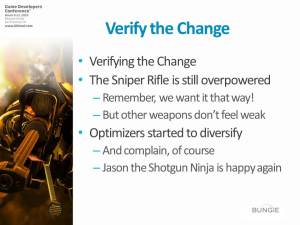“Iron sharpens iron, and one man sharpens another”
-Proverbs 27:17 [ESV]
“The whats-it is too powerful.” It could be a weapon, an RTS unit, a character in a fighting game, a multiplayer class… it doesn’t matter because all chronic balance problems follow the same general pattern. The game starts to revolve around a single dominant element, which is inherently overpowered and reduces the game’s strategic complexity, ultimately limiting its longevity. Nobody notices when a single element is too weak, because they just avoid it. And nobody complains when a dominant element increases strategic complexity, because that makes the game better and more fun. And a simple problem, like a damage value that is just set too high, usually has a simple solution that is quickly applied. But for chronic, fundamental balance problems, the designer is repeatedly faced with the same decision. Should the dominant element be weakened for the sake of balance? (Hint: The correct answer is always “NO!”)
Perception is Reality
First, it is important to recognize that the only “balance” that matters is the balance that players perceive. The goal of balance is longevity, and if players continue to play because they believe the game is fair, it doesn’t matter if it is objectively balanced in some measurable sense. In fact, if a large enough community perceives the game to be balanced, but your metrics claim it isn’t, then the metrics are wrong.

Sometimes power is deceptive
So often the problem isn’t that an element is too powerful, but that it feels too powerful. Maybe its a gun with a really great firing sound. Or a new unit that players haven’t figured out how to counter yet. Or perhaps it appeals more to skilled players or everyone is using it because it is new and novel. These problems usually fix themselves if they are left alone. I changed the perception of an “overpowered” weapon during Halo’s development just by announcing that I had fixed it (even though I hadn’t actually changed anything.)
The Tooth Fairy is Overpowered
In almost every case, there is no such thing as an “overpowered” element; there are well-tuned elements in a crowd of underpowered, ill-tuned alternatives. The Sniper class is implemented and all of the sudden you can’t take three steps without being headshot from across the map. The problem is not that the Sniper is strong, but that the Medic and the Engineer are weak. It’s easier to make a potent Sniper, so it immediately outclasses the rest. Instead of spending time figuring out how to cripple the Sniper, focus on making the other classes equally awesome. Or better yet, ditch the ones that will never feel as powerful as the Sniper and choose different classes that have their own natural strengths.

His only weakness is his terrible agent
Too Powerful, or All-Powerful?
In the paper design balance pass, every element should have been given a role to fill. Sometimes an element breaks the balance by breaking its designated role. An anti-vehicle missile that can be used against a crowd of infantry. A “glass cannon” that can hold his own in a melee fight. A long-distance weapon that is just as effective at point-blank range. The solution in this case is not to weaken the element, but to restrict it so that its strength cannot be applied in as many situations.
Often it takes ingenuity to limit a weapon without weakening it, but it isn’t as difficult as it might seem initially. A global weakness will affect the player in every situation, so a heavy-handed global weakness will be a constant irritation. But a specific limitation will only be felt when an element is being used outside its role, which a player can learn to avoid, eliminating the annoyance entirely. Nobody complains that their fancy sports car doesn’t work underwater, they just stay on the bridge.
[Continued in Balance of Power II]






































































